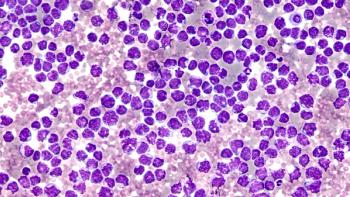
Trial Supports Subcutaneous Isatuximab as Effective Alternative to IV Version: Xavier Leleu, MD, PhD
The phase 3 IRAKLIA trial found that subcutaneous isatuximab delivered via an on-body system was as effective and safe as intravenous (IV) administration in relapsed/refractory multiple myeloma, according to Xavier Leleu, MD, PhD.
In part 2 of his conversation with The American Journal of Managed Care® at the
The trial found that subcutaneous isatuximab delivered via an on-body delivery system was as effective as the traditional intravenous (IV) form in patients with relapsed/refractory
Based on these findings, Leleu underscores the potential of subcutaneous isatuximab via on-body delivery to enhance both patient experience and clinical efficiency. Watch
This transcript was lightly edited; captions were auto-generated.
Transcript
Can you summarize the key findings of the phase 3 IRAKLIA trial? How does subcutaneous isatuximab delivered via on-body systems compare with traditional intravenous (IV) administration?
Subcutaneous vs IV: it's a non-inferiority study, and you have 2 co-primary [end points], so you have to be non-inferior for the 2 co-primary [end points]; it's as simple as that. [The] overall response rate was similar across arms, and the lower boundary of the 95% CIs of the analysis of the overall response rate was above the lower margin for the non-inferiority, meaning [that] this first primary end point of the 2 co-primary end points is actually [a] non-inferior, positive study.
The second one, Ctrough, at pre-cycle 6 steady-state status, is similar. It's actually non-inferior as well. It's actually higher in the subcutaneous vs IV, but it meets the non-inferiority-needed criteria for the 2 co-primary [end points] being non-inferior and the study being positive. On the basis of that, IRAKLIA is a positive study, so subcutaneous formulation is non-inferior to the IV. It's good for registration.
Now, as a clinician, I need more. As a clinician, I need the subcutaneous to be much better for [a] certain number of other key secondary end points. Overall response rate is great, but we know the deepest response is better for myeloma. It's great that Sanofi looked at VGPR [very good partial response] in beta. The VGPR in beta was very much the same across arms. Again, non-inferior, great.
The Ctrough, very early on [in] cycle 2, was, again, slightly higher for the subcutaneous but met non-inferiority—absolutely great. The quality of life, the PRO [patient-reported outcome], this is extremely key. You expect the subcutaneous to be much better tolerated than the IV, but you still have to demonstrate that. The PRO clearly demonstrated that the quality of life of the subcutaneous was actually superior, much better than [that] of the IV. More importantly, globally, it was better, but the very satisfied patient, the patient [who] loved the drug, actually, it was even better than the IV. Really, it was quantitatively better and quite qualitatively better, so this is really a success.
We also [analyzed] the infusion reactions. The principle of subcutaneous is that you want the drug to be ambulatory. You want the first injection to be in the outpatient clinic. You don't want to have to hospitalize your patients anymore, so you need the first injection to be safe in regard to what we call the infusion reaction, the systemic infusion reaction. You need that to be mitigated significantly with the sub-q version so [that] you can say, "Okay, 100% of my patients, I'm confident I can start the first injection in the outpatient clinic. I can make it fully ambulatory."
In IRAKLIA, the infusion reaction was 25% for the IV. It was 1.5% and only grade 1 for the subcutaneous. It's actually probably one of the best infusion reaction rates we've seen with [the] subcutaneous formulation.
Finally, when you use a subcutaneous formulation, you will have [a] local reaction, and you need the local reaction to be [as minimal] as possible. We were very surprised. It's actually very surprising, by the way, really surprising that only 0.4% of the patients had a local reaction, much lower than the regular manual push subcutaneous formulation.
Why is this OBI [on-body injector] so great? Why is this OBI a parting shift way of giving the secure formulation? Why is this OBI, I believe, going to make such a tremendous difference for the teams, for the patients, and for the nurses?
It's a small automated device. You fill it in with the vial, and then you stick it to the skin of the patient. You push the button, [and] it's totally automated. You don't see the needle, so you cannot have sharp injuries, and you are not stressed by the needle. The needle [is inserted] into the skin of the patient. The needle is a very tiny, thin one, much smaller than the usual subcutaneous [verison] we use. Once it's done, it retracts again, with no sharp injuries.
The needle and the product, because it's automated, will be individualized. It will consider the thickness of your skin. If you have very soft, lovely skin, it will inject within 12 or 13 minutes, maybe 10 minutes. If it's thicker, it will take slightly more time, but 97.9% of the patients actually had completion by 20 minutes. The median was 30 minutes, and 99.9% of the patients had a fully complete treatment on the OBI as expected, which proved that the OBI never failed.
You can have confidence that the flat dose of isatuximab, 1400 mg, works for everyone, for every subgroup, but you can be confident that the OBI device also works 100% of the [time] for all of the patients, independently of how thick [their] skin [is]. Really, it's deliverable to everyone and individualized to the type of skin you have.
To conclude, IRAKLIA is a positive study. The development of the OBI, I think, is really incredibly smart. It's new. I never thought we could improve a subcutaneous formulation. I never thought we could move from manual push to something else, and here we have something else that seems to be so much better.
I'm very happy for the patients. I'm very happy for the nurses and for the physicians. I'm very happy for the whole myeloma community.
Newsletter
Stay ahead of policy, cost, and value—subscribe to AJMC for expert insights at the intersection of clinical care and health economics.













































